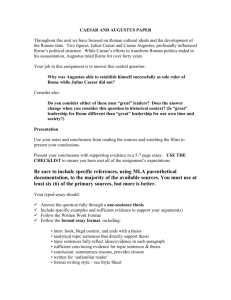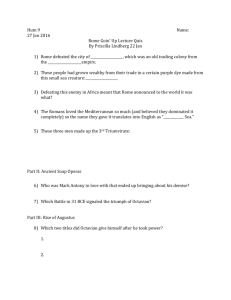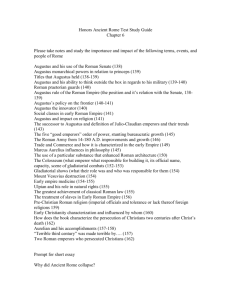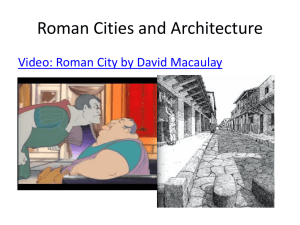Study Guide: HIST 3840, Ancient History (Exam 1, Spring 2012
advertisement
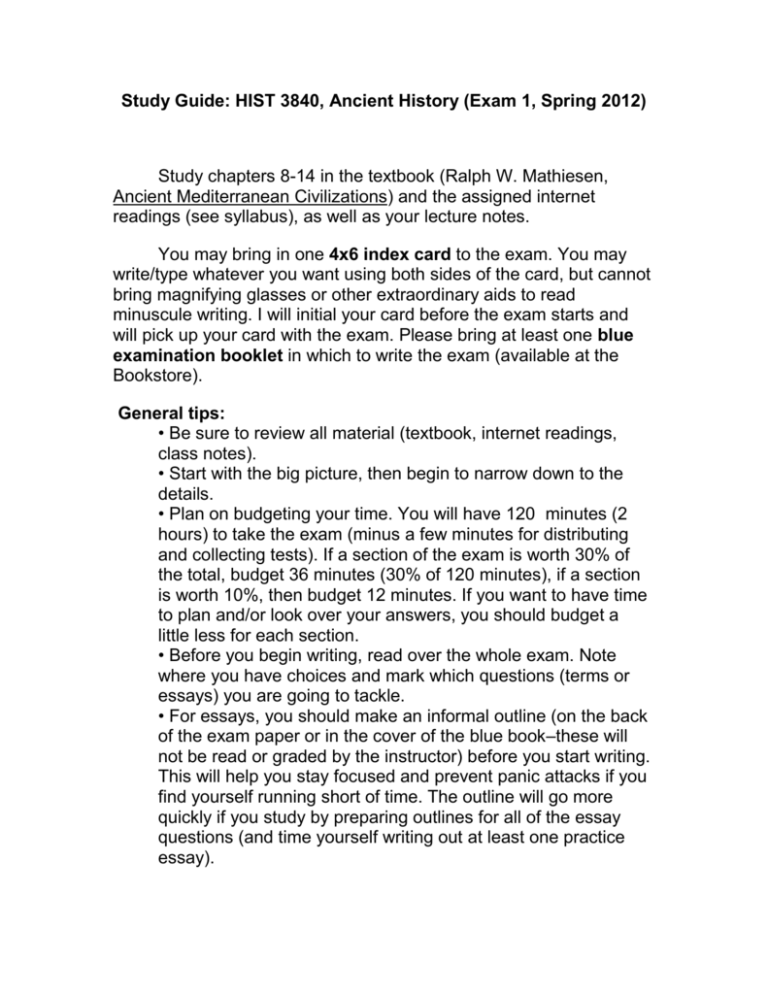
Study Guide: HIST 3840, Ancient History (Exam 1, Spring 2012) Study chapters 8-14 in the textbook (Ralph W. Mathiesen, Ancient Mediterranean Civilizations) and the assigned internet readings (see syllabus), as well as your lecture notes. You may bring in one 4x6 index card to the exam. You may write/type whatever you want using both sides of the card, but cannot bring magnifying glasses or other extraordinary aids to read minuscule writing. I will initial your card before the exam starts and will pick up your card with the exam. Please bring at least one blue examination booklet in which to write the exam (available at the Bookstore). General tips: • Be sure to review all material (textbook, internet readings, class notes). • Start with the big picture, then begin to narrow down to the details. • Plan on budgeting your time. You will have 120 minutes (2 hours) to take the exam (minus a few minutes for distributing and collecting tests). If a section of the exam is worth 30% of the total, budget 36 minutes (30% of 120 minutes), if a section is worth 10%, then budget 12 minutes. If you want to have time to plan and/or look over your answers, you should budget a little less for each section. • Before you begin writing, read over the whole exam. Note where you have choices and mark which questions (terms or essays) you are going to tackle. • For essays, you should make an informal outline (on the back of the exam paper or in the cover of the blue book–these will not be read or graded by the instructor) before you start writing. This will help you stay focused and prevent panic attacks if you find yourself running short of time. The outline will go more quickly if you study by preparing outlines for all of the essay questions (and time yourself writing out at least one practice essay). I. Terms (4 out of 8 terms; 10% each; 30% total) Terms will be taken from the lectures and readings. A good start would be to study the hints for the essay questions below, but be sure that you look at each day's readings and notes to make sure that you are not missing any important terms. Write a substantial paragraph on each term (5 sentences or longer). Be sure to address the questions Who? What? When? Where? and Why? (both "why important" and "why it happened"). II. Technical Terms (2 out of 4 terms; 5% each; 10% total) Terms will come from the technical terms given at the beginning of each class period; write a strong paragraph for each term. Half of your credit will come from writing a short definition of the term or description of the concept (1 or 2 sentences). The other half will come from at least one specific example of how this concept can be used to research or understand ancient history (3 or 4 sentences). Terms: numismatics, palynology, prosopography, demography, diplomatics, paleography, iconography, hagiography, II. Essay (1 of 2 essays; 30% total) TWO of the following will appear on the mid-term exam. You will write on ONE of them. I will grade your essay based on coverage of relevant historical facts, reference to appropriate primary sources, understanding of historical debates and interpretations, overall organization and argument, and writing ability (clear style, correct grammar). The hints below are to aid you in studying, but will not appear on the exam. Primary sources (be prepared to discuss at least one primary source in each essay and to be able to write a paragraph for the Terms section): Anecdotes about Alexander (Plutarch and others); Athanaeus, “Procession of Ptolemy”; Twelve Tables; Cicero against Marcus Antonius; Tacitus, “Germania”; Eusebius on the Conversion of Constantine; Athanasius, “Life of Anthony”; Ammianus Marcellinus; Priscus on Attila the Hun. (Bonus: Sidonius Apollinaris and Salvian.) 1. Compare and contrast the empires of Alexander the Great and Augustus Caesar. Consider how each man acquired the empire, how he ruled it, and the fate of the empire after his death. Hint: Macedonia, Greece, Philip of Macedon, Aristotle, Alexander the Great, Greek city states, Persia, satrapies, Egypt, India, Hellenistic culture, Stoic philosophy, Alexandria, civil wars, successor states, Seleucids, Antigonids, Ptolemies, Mauryans, Rome, Julius Caesar, Augustus Caesar, Roman Republic, Senate, civil wars, consul, dictator, emperor, public works, aqueducts, roads, temples, patronage of the arts, Vergil, Ovid, Julio-Claudian emperors, Good Emperors 2. Discuss the geographical expansion of the Roman Empire. To what extent was it the result of planning and to what extent the result of happenstance? Hint: Romans, Latins, Etruscans, Sabines, Celts, Germanic tribes, Berbers and other Africans, Egyptians, Greeks and Macedonians, Hebrews, Persians and other easterners; Italy, Gaul, Spain, Britain, Numidia, Libya, Egypt, Syria, Anatolia, Macedonia, Greece; Punic wars, Social War, Marius and Sulla, Julius Caesar, Cleopatra, Augustus, Diocletian, Constantine 3. Discuss the tension between family and state in the Roman Republic and early Empire (through the death of Augustus). Consider how this is reflected in myths and legends, laws, and political developments. Hint: Tarquin the Proud, rape of Lucretia, patricians, plebeians, three types of marriage, Senate, Twelve Tables, Marius, Sulla, Social War, Gaius and Tiberius Gracchus, Julius Caesar, first triumvirate, Crassus, Pompey, crossing the Rubicon, Brutus, Octavian, Augustus, second triumvirate, Lepidus, Marc Antony, Cleopatra, Octavia, Augustus, Julio-Claudian Emperors 4. Trace Roman religion from the beginning of the Republic until the fall of the western Empire in 476. Consider the impact of various religious ideas from the Mediterranean and beyond (including Christianity). Hint: polytheism, syncretism, Greek religion, Etruscan religion, Roman religion, superstitio and religio, household gods (lares and penates), omens, offerings, temples, Sybiline books, Stoic and Epicurian philosophies, Isis, mystery religions, household gods, epic poetry, Iliad, Odyssey, Aeneid, Judaism, Torah, Temple in Jerusalem, Pharisees, Sadducees, Essenes, Dead Sea Scrolls, apocrypha, pseudepigrapha, Jesus, apostles, gospels, Paul, bishops, councils, heresies, Monophysites, Donatists, Gnostics, Arians 5. Discuss the position of women in the Roman world from the Republic until the end of antiquity (roughly 600 CE). Consider women of all social classes, including both “Roman” and “foreign” women. Hint: three types of marriage (conferreatio, coemptio, usus), naming practices, political marriages, motherhood, Cornelia (mother of the Gracchi), Julia (aunt of Julius Caesar), Livia (wife of Augustus), Julia (daughter of Augustus), pater familias, (mater familias), law of three (or four) children, household gods, Vestal Virgins, Cleopatra, Christianity, agrarian households, urban households, slaves, prostitutes 6. Discuss the different theories for the fall of the Roman Empire in the west. Hint: Edward Gibbon, lead pipes, bread and circuses, debasement of coinage, wage/price controls, depopulation, Germanic tribes, “billiard ball” theory, military organization, foederates (confederates), Senate, succession, communications, Constantinople, Christianity, civic engagement, Romulus Augustulus, Huns, slavery 7. Discuss the problems facing the Roman Empire from the death of Augustus until the reign of Diocletian. Hint: Roman Republic, civil wars, Senate, emperor, Pax Romana, imperial succession, Julio-Claudian line, provinces, citizenship, army, confederates (foederati), Good Emperors, Crash of the Third Century, debasement of coinage, military changes, Diocletian, persecution of Christians, division of empire 8. Compare and contrast the successor states to Alexander the Great’s empire with the successor states to the Roman Empire after 476. Hint: Seleucids, Antigonids, Ptolemies, Mauryans, Hellenistic culture, philosophy, Stoics, Epicureans, geometry, Euclid, geography, Ptolemy of Alexandria, Alexandria, Justinian, Byzantine Empire, Franks, Visigoths, Ostrogoths, Vandals, Anglo-Saxons, Christianity, Roman law, Heraclius, Islam III. Overall Essay (1 of 5; 20%). This essay is modeled on the Major Field Assessment that the History Department has developed to measure how well students have mastered both the content and the theoretical framework of history. Directions: In a full essay of at least five paragraphs, respond to ONE of the following with specific reference to topics covered in this course (HIST 3840, Ancient History). Be sure to make clear which essay option you chose. YOUR ESSAY MUST BE ON A DIFFERENT TOPIC FROM THE ESSAY CHOSEN IN SECTION II. A. Periodization: Identify and discuss a question of historical periodization. Why have historians identified the era in question as a distinct historical period and what perspectives or considerations suggest alternative patterns of continuity and change? B. Causation: Identify and discuss a significant event or development attributed by historians to multiple short-term and long-term causes. What approaches to understanding historical change (political, economic, social, cultural, etc.) does each factor represent, and how do you rank their relative importance? C. Context: Identify and discuss a historical subject for which you believe considerations of context are especially important in forming value judgments. D. Primary Evidence: Identify and discuss an instance in which the examination of a primary source (or sources) has significantly challenged or changed your interpretation of a historical subject. E. Historiography: Identify and discuss a historical interpretation that has changed significantly over time. What factors, internal and external to the discipline of history, contributed to this change? IV. Map (1% each; 10% total) Be able to find the following places on a map of the Mediterranean and surrounding areas. See maps on inside covers of the textbook. Places marked with a star (*) have been discussed in class but are not labeled on the flyleafs of the book; many, however, can be found in the smaller maps in the assigned chapters of the textbook and in standard reference works. Atlantic Ocean Greece *Asia Minor Aegean Sea Syria Mediterranean Judea Sea Mesopotamia Egypt Adriatic Sea Macedonia Tyrrhenian Sea Arabia Persian Gulf Red Sea Gaul Black Sea Spain English Channel Germania *Britain Danube River Rhine River Nile River Sahara Desert Jerusalem Arabian Desert Rome Crete Milan Cyprus Sicily Constantinople Crete Alexandria (Egypt) Sardinia Naples Corsica *Pompeii Caucasus Mts. Balkans Mts. Athens Carthage Alps Syracuse Pyrenees Mts.
